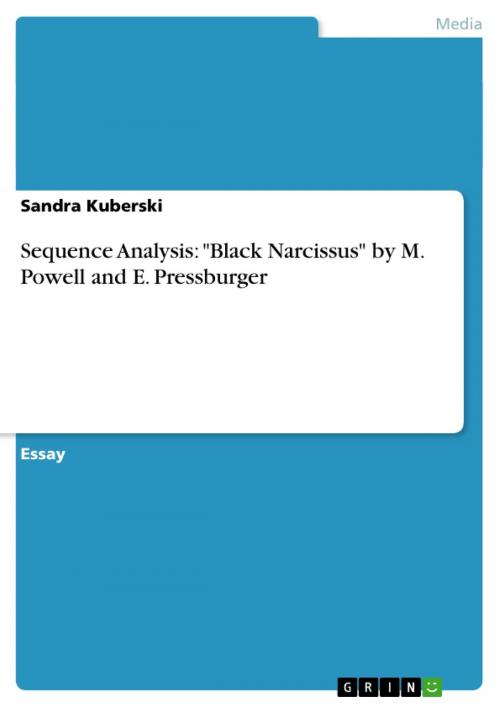Sequence Analysis: 'Black Narcissus' by M. Powell and E. Pressburger
Nonfiction, Entertainment, Performing Arts, Film| Author: | Sandra Kuberski | ISBN: | 9783656859833 |
| Publisher: | GRIN Verlag | Publication: | December 15, 2014 |
| Imprint: | GRIN Verlag | Language: | English |
| Author: | Sandra Kuberski |
| ISBN: | 9783656859833 |
| Publisher: | GRIN Verlag |
| Publication: | December 15, 2014 |
| Imprint: | GRIN Verlag |
| Language: | English |
Essay from the year 2012 in the subject Film Science, grade: 1,3, University of Essex (Film), course: Introduction to Film, language: English, abstract: 'The Black Narcissus' is a British film from 1974, directed by Michael Powell and Emeric Pressburger and based on the same-named novel by Rumer Godden. The aim of this essay is a detailed analysis of a sequence close to the end of the film. It consists of roughly five scenes: the first scene shows natives drumming in the jungle. In the next scene the spectator is transferred to the hallways of the Convent, where Sister Clodagh (Deborah Kerr) searches for Sister Ruth (Kathleen Byron). The third scene shows the occurrences between those two in Sister Ruth's room and her final flight, the fourth is composed of the search of the nuns for Sister Ruth and the sequence has its climax when Sister Ruth visits Mr. Dean, confesses her love and in the end faints. Furthermore it will be examined, how the cinematic techniques underline the main themes and to what extent film language mediates a sense of foreboding to the spectator. As a whole, the film deals with the fall of the British Empire, here represented through the failing missionary work of the nuns. The chosen sequence itself, however, deals with the consequences of the tantalising setting on the Sisters and their repressed sexuality which takes overhand. Most striking is thereby the juxtaposition of Clodagh and Ruth, who are shown as mirror images. Whilst the one overcomes the temptation, the other one falls for it and - when repulsed by Mr. Dean - in the end loses control and becomes insane.
Essay from the year 2012 in the subject Film Science, grade: 1,3, University of Essex (Film), course: Introduction to Film, language: English, abstract: 'The Black Narcissus' is a British film from 1974, directed by Michael Powell and Emeric Pressburger and based on the same-named novel by Rumer Godden. The aim of this essay is a detailed analysis of a sequence close to the end of the film. It consists of roughly five scenes: the first scene shows natives drumming in the jungle. In the next scene the spectator is transferred to the hallways of the Convent, where Sister Clodagh (Deborah Kerr) searches for Sister Ruth (Kathleen Byron). The third scene shows the occurrences between those two in Sister Ruth's room and her final flight, the fourth is composed of the search of the nuns for Sister Ruth and the sequence has its climax when Sister Ruth visits Mr. Dean, confesses her love and in the end faints. Furthermore it will be examined, how the cinematic techniques underline the main themes and to what extent film language mediates a sense of foreboding to the spectator. As a whole, the film deals with the fall of the British Empire, here represented through the failing missionary work of the nuns. The chosen sequence itself, however, deals with the consequences of the tantalising setting on the Sisters and their repressed sexuality which takes overhand. Most striking is thereby the juxtaposition of Clodagh and Ruth, who are shown as mirror images. Whilst the one overcomes the temptation, the other one falls for it and - when repulsed by Mr. Dean - in the end loses control and becomes insane.















